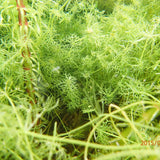Callitriche Stagnalis Aquatic Pond Plant - Starwort
Callitriche stagnalis, commonly known as Starwort or Common Water-starwort, is an aquatic plant species that can be found in freshwater habitats such as ponds, lakes, and slow-moving streams.
Here is a detailed description and care guide for Callitriche stagnalis:
Description:
Callitriche stagnalis is a small, delicate plant with slender stems and opposite leaves. The stems can grow up to 20 cm (8 inches) in length and are typically submerged in water. The leaves are small, narrow, and have a distinct star-like shape, giving the plant its common name. The leaves may vary in color from bright green to reddish-green. It can form dense mats or floating clusters in the water.
Care Guide:
Lighting:
Callitriche stagnalis prefers moderate to high light levels. Provide a minimum of 2-3 watts per gallon of full-spectrum light for optimal growth. If grown outdoors, ensure it receives partial shade to avoid excessive sun exposure.
Water Parameters:
Maintain a water temperature between 18-26°C (64-79°F) for optimal growth. The pH level should be slightly acidic to neutral, ranging from 6.0-7.5. It can tolerate a wide range of water hardness, but prefers soft to moderately hard water.
Nutrient Requirements:
Starwort can adapt to a variety of nutrient conditions. It can absorb nutrients directly from the water column but can also benefit from supplemental fertilization. Adding a liquid fertilizer or root tabs rich in macro and micronutrients can promote healthier growth.
Substrate:
Although not mandatory, a nutrient-rich substrate can provide additional nourishment for the plant. A fine-grained substrate like sand or a specialized aquatic plant substrate is ideal for root establishment.
Propagation:
Callitriche stagnalis can reproduce through both vegetative and sexual propagation. Vegetative propagation occurs when the plant produces side shoots that can be separated and replanted. Sexual propagation occurs through the production of flowers and subsequent seed formation.
Maintenance:
Regular pruning is generally not required, but occasional trimming may be necessary to maintain the desired shape and prevent overgrowth.
Remove any dead or decaying plant matter to maintain water quality.
Ensure good water circulation to prevent stagnation and maintain oxygenation.
Compatibility:
Callitriche stagnalis is a versatile plant that can be used in various aquarium setups, including community tanks, shrimp tanks, and planted aquariums. It provides hiding places and grazing areas for small fish and invertebrates.
Overall, Callitriche stagnalis (Starwort) is a beautiful and adaptable aquatic plant that adds a natural touch to freshwater aquariums. With proper care and suitable water conditions, it can thrive and provide a visually appealing environment for aquatic inhabitants.
Selection of Plants:
Choose appropriate oxygenating plants that are suitable for the size and depth of your pond. Common oxygenating plants include Hornwort (Ceratophyllum), Anacharis (Elodea canadensis), Waterweed (Elodea densa), and Watermilfoil (Myriophyllum species).
Placement:
Place oxygenating plants in the water at a depth where their foliage is fully submerged. Distribute the plants evenly throughout the pond, ensuring they receive adequate sunlight for photosynthesis.
Water Quality:
Oxygenating plants play a crucial role in maintaining good water quality by absorbing excess nutrients, competing with algae for resources, and releasing oxygen through photosynthesis. Regularly monitor water quality parameters such as pH, ammonia, nitrite, and nitrate levels to ensure they are within suitable ranges for the plants.
Nutrient Levels:
Oxygenating plants benefit from moderate nutrient levels in the water, but excessive nutrients can lead to rapid algae growth. Avoid over-fertilization or excessive organic matter accumulation in the pond, as it can negatively impact oxygenating plants.
Pruning and Maintenance:
Regularly thin out and prune oxygenating plants to prevent overcrowding and ensure healthy growth. Remove any dead or decaying plant material promptly to maintain water quality and prevent the release of excess nutrients.
Winter Care:
Some oxygenating plants may need special attention during winter, especially in colder climates. If your pond experiences freezing temperatures, consider moving potted plants indoors or provide insulation to protect them. In milder climates, oxygenating plants may continue to grow during winter, providing oxygen and supporting the pond ecosystem.
Propagation:
Some oxygenating plants can be propagated by dividing or taking cuttings. Follow specific instructions for each plant species to propagate them successfully and maintain a healthy population in your pond.
Monitoring and Control:
Regularly observe the growth and condition of oxygenating plants to identify any signs of disease, pests, or nutrient deficiencies. If needed, control excessive growth by removing excess plant material, but be careful not to remove too much at once, as it can disturb the pond's ecological balance.
Introduction of New Plants:
Before introducing new oxygenating plants into your pond, ensure they are free from pests, diseases, or invasive species. Avoid introducing non-native species that may become invasive and harm the local ecosystem. By following these general tips and care guidelines, you can maintain healthy oxygenating plants in your pond. They will contribute to the overall oxygenation of the water, provide habitat for beneficial organisms, and promote a thriving pond ecosystem.
































